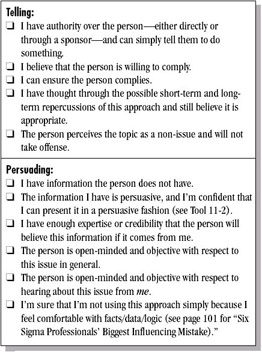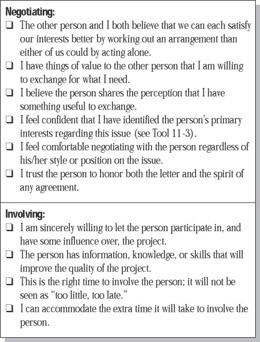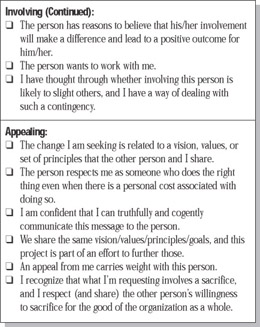More on Negotiating
As you work to complete your Six Sigma project, you will have to influence many people in order to get cooperation for your project, and the same approach doesn’t work with everyone. So you’ll need to be familiar with a variety of influence approaches (or strategies) and know how to choose among them.
Definition:
Influence refers to the use of personal energy to create an impact upon, redirect, or change the outcome of a particular situation.
Key Principle:
Influence strategies fall on a continuum (see below), with one end being those that push people into action and the other being those that pull them (i.e., create a situation in which people want to do something).
What makes one influence strategy more appropriate than another is a combination of:
-
the situation
-
you and your capacity to influence
-
the person you’re trying to influence

What to Do:
-
Read through the Checklist: Influence Strategies (Tool 11-1) items, considering whether they apply to your situation. Put a check next to those that do.
Checklist: Influence Strategies
Tool 11-1.



-
Analyze your responses:
-
Look at the strategies with the most checks.
-
Consider whether all checks are equal, or whether some items have more weight in this situation; if some deserve more weight, assign additional checks to them.
-
Rank-order the strategies based on checks (adjusted for weight) and your own judgment (does the strategy seem to make sense?).
-
-
Use this ranking as a guideline for helping you select the appropriate influence strategy for this person.
Checklist: Is Your Data Persuasive?
Tool 11-2.

Six Sigma Professionals’ Biggest Influencing Mistake
When it’s time to influence people, Six Sigma professionals tend to reach for the same strategy every time: persuasion. In many cases, this is a good approach and it works quite well. But Six Sigma professionals often do this even when the other person already has the data, or has already taken it into consideration, or is not open to hearing it. In these situations, persuasion simply doesn’t work.
Why Does This Happen?
People tend to use influence approaches that seem logical to them and have worked well in the past. As someone with experience in Six Sigma and its focus on data-based decisions, you can easily draw the conclusion that using data is the best way to influence someone. When it doesn’t work, you may think it’s because you don’t have enough data, so you look for more and try again ... and again....
What Can You Do to Avoid This Tendency?
Recognize that people consider many factors as they make decisions, and you often have to move beyond the data—even though this may seem like a betrayal of Six Sigma principles! Become familiar with the five influence strategies and when they are appropriate. Use the checklist to pick an approach. Try out the other strategies and see what happens. Don’t let your preferred style get in the way of doing what will work best with this person in this situation.
EAN: 2147483647
Pages: 65